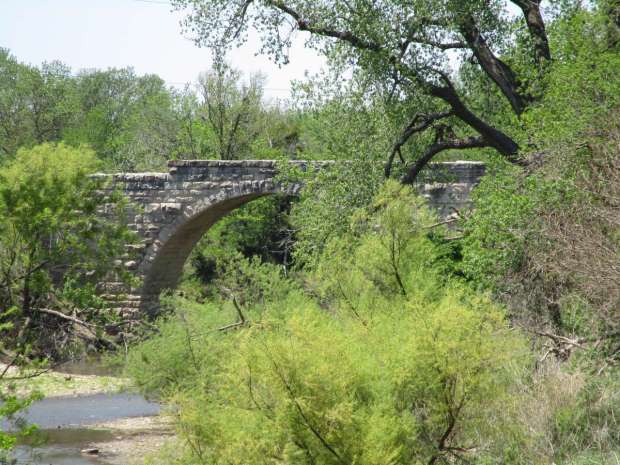The Flint Hills of Kansas are home to many stone arch bridges made of the local limestone. However, before these picturesque and durable bridges could be built some objections had to be overcome.
The Obstacles
The main objection to building stone bridges was the cost of a new stone bridge. And it was true that some of the earliest stone bridges built in the Flint Hills, such as the famous Clements Bridge in Chase County, cost a small fortune.

Could a stone bridge be built that was affordable? The new counties did not have the money to invest in fantastically expensive structures; there were many streams that must be bridged and not much money to do it with. And then, too, the stone arch bridge was something of a novelty. Would they actually survive the Flint Hills floods? Could a reasonably priced stone bridge be built that would actually stand the tests of time, or would the counties be throwing away money to try?
To make matters worse, the steel bridge companies were not planning on sitting back quietly and watching business dry up. As far as the steel bridge companies were concerned, these stone arch bridges must not be built. One builder of stone bridges, Walter Sharp, many years later, reported that, when about to bid on the first major stone bridge in Greenwood County, he was offered a bribe which he would receive if he did not build the stone bridge, and he was also threatened as to what would happen to him if he did build the stone bridge. Sharp also indicated that the steel bridge companies tried to lobby after their own fashions to keep various county commissioners on their side in Cowley County. After Cowley had been building stone bridges for a while, a steel bridge company actually bid on a stone bridge at a very low price, hoping to win a contract and regain some influence in the county bridge matters. This attempt failed, for the county commissioners decided it would be best not to let the contract to this company, which had never even built a stone bridge before.
Overcoming Obstacles
There can be no doubt but that newspaper campaigns in favor of the stone bridge were largely responsible for convincing people to try building stone bridges. The newspapers continually reminded people of the durability of the stone bridge, and how if stone bridges were built the money spent would be paid to local builders instead of the money being sent out of the area to various large steel bridge monopolies. The end result was invariably an “experimental” stone bridge, the newspapers convincing people to try just one stone bridge for the start and see how they liked it.
Starting Small
Most Flint Hills counties started relatively small in their stone bridge endeavors. Stone arch culverts became a common replacement for the old plank culverts throughout the region; many of these tiny structures remain in the Flint Hills waiting to be “rediscovered.”

Stone culverts became common, and, in the end, all major Flint Hills counties built a good number of stone culverts. Some went further, and built major bridges, continuing to build stone culverts all the while for these stone culverts were considerably better than plank culverts. Chase County built many major stone bridges, though, sadly, most of these well-built structures were demolished in more recent years. Marion County built a few big bridges, and ended up being a pioneer in the Flint Hills region. And it was partly because of Marion’s work that Butler County ended up taking the lead, and made the stone arch bridge a common sight.

